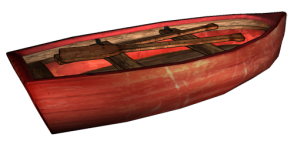Last year I’ve been working on a nice little browser game, which was released some time ago.
It’s called “The Big Catch”. I played it for a few hours, and have to say that it’s nice light entertainment, and can be real fun if you are into fishing and familiar with the routine.
For this purpose I created various low-poly 3D-game assets and environments, which you can see in the game. I modeled the objects and, with directions and help from the studio I did the freelancing for (http://www.polygonfabrik.de) I developed a comic-like, easy-on-the-eyes texture style for the environment.
Creating a distinct texture/shader style for a game, a short movie or just a still rendering is one of the most interesting and exciting processes for an artist. I decided to write about it because that’s part of what I do on my current job.
There have been written countless books about the technical aspects of applying textures to objects, about shader programming and brush painting, and making photographs tileable. But before all that, there are various other steps to take until you can really get down to work.
It always helpful to ask yourself the following questions during the creative process:
- How will the style of the textures complement and suit the content I’m trying to transmit?
First and foremost (as an artist) you will always have the exciting task to deliver a message through visual information. So with every part of the production (if it is a movie or a game or something else entirely) you must always support the content of your product via the graphics. This is a very basic rule, but not always easily to be followed! Once you make it your priority, your product has great chance to become more appealing for the audience. Of course, this also goes for the textures, as they play a big part in the visual information the viewer is going to receive. An example: In The Darkness II, a very distinct cel-shading look has been used, which emulates the aesthetics of the graphic novel namesake. It supports the dark and twisted nature of the game.
- How will the textures work as in-game/rendered shaders and how will they interact with the lighting?
A texture always looks different in your 2D graphics program from the actual end product. Keep testing various looks in the engine/renderer. Depending on the shader and light setups, small changes in the texture can have huge effects on the outcome.
- When the texture is applied, are the forms of the objects still readable in the composition?
Very often, texture that is too detailed or busy makes an image harder to read instead of making it visually clearer. If possible, go back and forth between working on the lighting and the shading/texturing the get the best results. Especially with games, a readable environment is very important when the player has to navigate her/his way through it. Of course it depends on the style of the product, but generally, you can depend on this basic rule to make your image clearer: Color contrast and saturation are the highest up close. The further away and object is, the less contrasted and saturated it appears. Manipulate your textures if needed to make the composition clearer.
- What workflow must be developed in order to create the texture look I want?
In a commercial production (as well as most student projects) you only have limited time to work on textures. Try to find a production routine! If the look has to be “hand-painted”, as it is so popular nowadays, try to think of alternatives: Does every bit of texture have to actually BE handpainted? Or are there faster ways to achieve that look (perhaps with filters, modifications of photos, etc.)? Also, an easy way to speed up your workflow is to simply create some Photoshop actions. (Have a look at this tutorial if you are unfamiliar with actions: http://www.lightstalking.com/photoshop-actions )
- What kind of resources are available?
The actual resources you have will have effect on the look of your product. Do you own a library with countless licensed high-res texture-photos? Do you have a great camera you can use for texture-photography? Do you have great painting skills, which could be of any use? What supplies are needed for creating an authentic non-digital watercolor-look? (Colors, Paper, Scanner, etc.) This also applies to human- and time-resources: Is there a programmer to help you with shader-development or can you do it on your own? How much time is scheduled in your project plan for the task of texture development and the texturing process?
Creating properly nice textures for your models can be time consuming, and sometimes there’s a lot of trial-and-error involved. But that’s also what makes it so much fun. In the end, the look of the textures and shaders and their interaction with the light setup will have significant impact on the whole aesthetic of your product.


